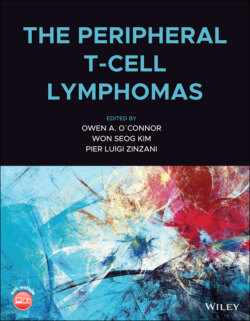Читать книгу The Peripheral T-Cell Lymphomas - Группа авторов - Страница 66
Future Directions
ОглавлениеAs discussed above, there are many lines of evidence that suggest that the T‐cell malignancies harbor many lesions that underscore its gross epigenetic dysregulation. In addition, it is clear that efficacy of epigenetic‐based monotherapies, which exhibit a clear lineage specific selectivity in the TCL, is only the first step in trying to leverage our growing understanding of these diseases in a treatment focused fashion in is limited. Combinations of drugs predicated on a HDAC inhibitor backbone appear to improve the efficacy of these agents, as demonstrated in phase I and phase II trials investigating HDAC or DNMT inhibitors. The combination of epigenetic modulating agents with immunotherapy provides perhaps the most exciting avenue for future research. Histone modification typically results in closed chromatin states at the MHC class II promoters, and in MCL and DLBCL cells this can be reversed by HDAC inhibition, thus enhancing antigen‐specific immune recognition and activation [137, 138]. In addition, DNMT inhibitors seem to increase sensitivity to immune‐checkpoint inhibition [139, 140]. Presently, a number of studies are systematically exploring the combination of immune checkpoint inhibitors with many of the agents descried above (romidepsin, decitabine, azacytidine, pralatrexate) as well as with various doublet combinations (ex 5‐azacytidine plus romidepsin, decitabine plus pralatrexate, and pralatrexate plus romidepsin). It is anticipated that, in the near future, these two‐ or three‐drug combinations will lead to a paradigm change in the disease, with a shift from the indiscriminate cytotoxic effects of chemotherapy, to likely immunoepigenetic‐based platforms.
Table 3.3 Combination agents targeting the T‐cell lymphoma epigenome.
| Drug combinations | Class/Mechanism | Disease | Patients (n) | ORR (%) | CR (%) | Median PFS (months) | Median DOR (months) | Refs. |
|---|---|---|---|---|---|---|---|---|
| Panobinostat/Bortezomib | HDACi and proteasome inhibitor | PTCL | 25 | 43 | 22 | 2.6 | 5.6 | [132] |
| Romidepsin/Pralatrexate | HDACi and folate antagonist | PTCL/CTCL | 14 | 71 | 29 | 4.4 | 4.3 | [133] |
| Romidepsin/Alisertib | HDACi and Aurora A kinase inhibitor | PTCL/CTCL | 3 | 33 | 33 | > 6 | nr | [134] |
| Romidepsin/Duvelisib | HDACi and PI3Kδ, −γ inhibitor | PTCL/CTCL | 11 | 64 | 36 | nr | nr | [135] |
| Romidepsin/Lenalidomide | HDACi and immunomodulatory agent | PTCL/CTCL | 10 | 50 | 0 | 13.5 weeks | nr | [136] |
| Romidepsin/Azacitidine | AITL | PTCL | 14 | 73 | 54 | 7.9 | NR | [52] |
CR, complete response; CTCL, cutaneous T‐cell lymphoma; DOR, duration of response; HDACi, histone deacetylase inhibitor; nr, not reported; NR, not reached; ORR, overall response rate; PFS, progression‐free survival; PTCL, peripheral T‐cell lymphoma.
